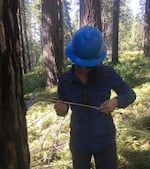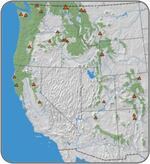
Researcher Christina Restaino collects core samples from Douglas fir trees.
Courtesy of Christina Restaino
A new study finds the West is likely to see slower-growing Douglas fir trees in the future, as temperatures and droughts increase with climate change.
Researchers with the University of California-Davis took core samples from 122 Douglas fir trees across the region to measure how fast the trees grew over a 91-year period.
The results clearly show that the trees grew more slowly in drought years, according to researcher Christina Restaino.
“We were able to find this species throughout its entire range grows slower when it is warmer and drier," Restaino said. "The trees respond to stressful growing conditions by growing less. It doesn't matter if it’s growing in Washington state or the Grand Canyon. When atmospheric water and soil moisture decrease, you’re going to end up with less growth."
Climate models show stressful growing conditions will be be more frequent in the future, and they’ll last longer as global temperatures rise.

Researchers collected core samples from 122 Douglas fir trees across the West.
Courtesy of University of California - Davis
Restaino said that means Western forests will likely produce less commercial timber and sequester less carbon as Douglas fir tree growth slows.
"Throughout the West, Douglas fir is our most widespread tree in terms of timber management," she said. "It’s a very important tree species because it spans so many different ecosystems and forest types in the West. It is a commercial species, and it’s an iconic, beautiful species – especially in the Pacific Northwest."
With more heat stress, she added, the trees will be more vulnerable to pests and diseases.
"The climate stress may not kill them, but the other things like beetles and diseases may be the ones to kill them once they’re stressed to their limits," she said.
Researchers are still working to calculate how much the tree growth slowed under dry conditions.
